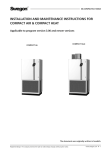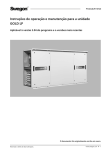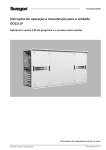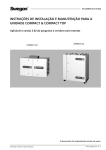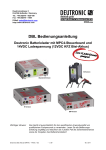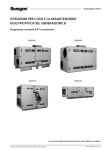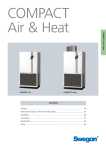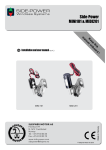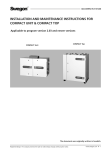Download COMPACT Control System
Transcript
COMPACT COMPACT Control System Hand-held Micro Terminal/Control Panel Heating, COMPACT Air & Heat Settings................................................................................. 64 Language.............................................................................. 64 Flow unit............................................................................... 64 Min./max. Setting.................................................................. 64 Initial Setting......................................................................... 64 Electric Air Heater.................................................................. 71 Manually Set Heating ............................................................ 71 Automatic Heating................................................................ 71 Controls Electric Air Heater.................................................................. 72 Air Heater for Hot Water....................................................... 72 Heating BOOST...................................................................... 72 Intermittent Night-time Heating............................................. 72 Morning BOOST.................................................................... 72 Preheating the Air.................................................................. 72 Controls ................................................................................ 64 Time switch clock (timer)....................................................... 64 Starting Sequence.................................................................. 64 Temperature Regulation ERS Regulation...................................................................... 65 Summer Night Cooling.......................................................... 66 Set Point Displacement.......................................................... 66 External Temperature Sensors................................................ 66 Supply Air Regulation............................................................ 67 Extract Air Regulation............................................................ 67 Outdoor Compensation......................................................... 67 Flow/Pressure Cooling Control Possibilities ............................................................... 73 Functions............................................................................... 73 Operational Functions Set from an Ext. Device Damper Control..................................................................... 74 Outputs................................................................................. 74 Inputs.................................................................................... 74 IQnomic Plus.......................................................................... 74 Alarms General................................................................................. 75 Alarm Limits.......................................................................... 75 Fire Alarms............................................................................ 75 External Alarms..................................................................... 75 Alarm Priority........................................................................ 75 Alarm Blocking...................................................................... 75 Communication Filters General................................................................................. 70 Filter Monitoring.................................................................... 70 General................................................................................. 76 Web Communication via Network ........................................ 76 Logging................................................................................. 76 Service Functions Rotary Heat Exchanger Controls................................................................................. 70 Defrosting............................................................................. 70 Cooling Energy Recovery....................................................... 70 Air Purging Operation............................................................ 70 Rotation Monitor................................................................... 70 Prolonged Heat Exchanger Operation.................................... 70 Temperature Efficiency Calculation........................................ 70 Airflow Adjustments.............................................................. 77 Readings................................................................................ 77 Manual Test........................................................................... 77 Registered design. The company reserves the right to make design changes without prior notice. 20090901www.swegon.com 63 COMPACT Control System Fan Regulation....................................................................... 68 Flow Regulation..................................................................... 68 Demand Control.................................................................... 68 Slave Control......................................................................... 68 Airing.................................................................................... 68 Pressure regulation................................................................ 68 Seasonally Compensated Airflow........................................... 68 Flow/pressure Regulation to min. set point............................ 68 Density-corrected Airflow...................................................... 68 Zero Calibration..................................................................... 68 Clean Air Contriol.................................................................. 69 Heating, COMPACT Unit & Top COMPACT COMPACT Control System Hand-held Micro Terminal/Control Panel Settings Language The language desired can be set here. Normally this setting is entered when the air handling unit is started for the first time and the question CHANGE? automatically appears on the control panel screen. However, the language setting can be changed at any time. Flow unit The flow unit desired can be set here. l/s, m3 /s, m3 /h. Min./max. setting Used for limiting the setting range at user level for setpoints and min. and max. limits of temperature. Initial setting The two base settings can be saved and used for setting the air handling unit for summer conditions and winter conditions, for instance. The settings can also be reset to the initial factory settings. However, the preset values for communication and alarm priority are not reset if the factory settings are reinstated. Controls Controls Starting sequence The unit normally operates in the automatic operation mode and is then controlled via the internal time switch clock (timer). The COMPACT system has a starting sequence with factory-preset time delay between each step as follows: It is also possible to control the air handling unit manually. In addition, the air handling unit can be externally controlled via communication or via external accessories such as presence detectors. The control unit has as standard two outputs and two inputs for external operation functions (with the TBIQ IQnomic Plus module the number of inputs and outputs respectively can be increased to four). The outputs can be used for indicating in-operation status and the inputs can be used for unit operation regulated via presence detectors, for instance. Time switch clock (timer) The current date and time can be set and preset and adjusted whenever required. The Time switch clock (timer) automatically takes leap years into consideration. The system automatically manages changes between summer/winter time to EU Standard. The function can, however, not be blocked. Times and days can be set when the unit is to run in the high speed mode, low speed mode or be switched off. Eight different time channels (scheduling) can be set. If the same in-operation periods are to apply every day of the week (Monday-Sunday), it will be sufficient to program one time channel. The year channels make it possible to set deviating inoperation times for certain periods in the year, such as longer holidays. Eight different year channels (yearly time schedules) can be set. 64 1.The damper relay is energised and opens the shut-off damper (if installed). 2.Time delay: 30 seconds. The extract air fan starts and rotary heat exchanger is controlled to the max. energy recovery setting. The air heater for hot water (if installed) is activated to generate 40% of its max capacity. 3. Time delay: 90 seconds. The supply air fan starts up. 4.Time delay: 90 seconds. The temperature regulation (control) function begins according to its regular settings. The starting sequence prevents the extract air fan from starting up if the shut-off damper is closed. By starting the extract air fan first, and controlling the heat exchanger to the max. recovery setting, the system also avoids chilling the premises with cool supply air under cold weather conditions. COMPACT COMPACT Control System Temperature regulation ERS Regulation 1 The control unit regulates the ratio between the supply air and extract air temperature according to a factory-preset curve. 1) Breakpoint in °C (based on the extract air temperature). 2) The temperature differential above the breakpoint is selected in steps. 3) The temperature differential below the breakpoint is selected in °C. See the diagram: ERS Regulation 1, to the right for COMPACT Air & Heat and COMPACT Unit & Top respectively. 22 ep St Ste p2 Step 1 ti a l 20 3 Breakpoint di ff er en 18 SA /E A 16 12 14 16 18 20 22 24 26 Extract air temperature °C Factory setting: Step 1. Breakpoint: 20°C. SA/EA differential: 2°C. Involves the following: If the extract air temperature is below 20°C (breakpoint), the supply air temperature setpoint will be automatically regulated to be 2°C (EA/SA differential) lower. If the extract air temperature is above 20°C, the supply air temperature setpoint will follow the curve according to Step 1. ERS Regulation 1, COMPACT Unit & Top 22 p Ste 20 Step 2 Breakpoint 18 Step 3 ff er en ti a l 16 1 SA /E A di 14 12 Step 4 10 12 14 16 18 20 21 22 24 26 Extract air temperature °C Factory setting: Step 1. Breakpoint: 20°C. SA/EA differential: 2°C. Involves the following: If the extract air temperature is below 20°C (breakpoint), the supply air temperature setpoint will be automatically regulated to be 2°C (EA/SA differential) lower. If the extract air temperature is above 20°C, the supply air temperature setpoint will follow the curve according to Step 1. 65 COMPACT Control System Control Sequence The temperature efficiency of the air handling unit’s heat exchanger is modulated to provide max. heat recovery. After that, the air heater for reheating, if installed, will begin to generate heat. If an air heater for reheating the supply air is not installed, or if the heating power in the air heater for reheating is not sufficient, the supply air fan or both the supply air and the exhaust air fans will automatically and variably be decelerated to discharge supply air at the min. airflow setpoint. A neutral zone can be preset, which allows a lower supply air temperature setpoint before the downspeed fan control (fan deceleration) function begins. When the supply airflow is regulated to a lower rate, the heat exchanger will have ”excess heat”, i.e. warm extract air, giving it capacity to attain and maintain the supply air temperature required. As the supply airflow is controlled to a lower rate, the air pressure in the premises becomes sub-atmospheric and this instead causes outdoor air to be sucked in through untight spots (leakage points) such as doors and windows. The ordinary heating system of the premises must be sized for heating this outdoor air. Supply air temp. setpoint °C ERS Regulation refers to Extract air temperature-Related Supply air temperature control. This means that the temperature of the supply air is regulated in relation to the temperature of the extract air. Under normal circumstances, the supply air temperature is regulated to be a few degrees lower than the extract air temperature. In this way, the heat exchanger will provide optimal performance, and this means excellent operating economy. ERS control is suitable for use when there is excess heat in the premises generated, for example, by machinery, lighting or people and the premises have supply air devices suitable for discharging air below room temperature. ERS Regulation is standard in the COMPACT Air and COMPACT Heat systems. ERS Regulation 1, COMPACT Air & Heat Supply air temp. set point °C ERS Regulation (control) COMPACT COMPACT Control System Temperature regulation ERS Regulation 2 Used if the factory preset performance curve in the ERS Control 1 function does not provide the results desired to meet special needs and conditions. Depending on what settings are entered, the installation of air heaters for reheating may be required. An individually adjusted curve regulates the supply air/ extract air temperature ratio. See the ERS Regulation Diagram to the right. ERS Regulation 2 22 Y = Supply air temperature setpoint °C ERS Regulation, continued 20 2 15 The lower temperature at night is utilized to cool down the building structure. If the function is activated, the air handling unit will, if required, operate in the high speed mode without energy recovery and without activating the air heater, if included in the system. This will cause the cooling load to decrease during the first hours of the day. If a cooling unit is installed, it will not need to be operated, thus offering savings. If no cooling unit is installed, a certain cooling effect will still be achieved. Set point displacement Set point displacement is used for changing the set point for supply air and extract air temperatures. The temperature can be increased or decreased at certain times of the day by means of an external timer or potentiometer, for instance. The set point can be influenced by ±5 °C by means of 0 10 V external control. External temperature sensors There is provision for connecting external temperature sensors, which can be used when the air handling unit’s internal sensor does not provide representative values. The External Extract air/Room function measures the extract air temperature in a larger room or in the duct system, instead of the temperature inside the air handling unit. A temperature sensor for location in a room, is included as standard for the COMPACT Heat system. The External Outdoor function measures the air temperature outdoors, instead of the temperature inside the air handling unit. 66 3 10 9 Summer night cooling 1 12 15 20 X = Extract air temperature °C 25 27 Factory settings – breakpoints: X1 X2 = 20 °C. X3 = 22 °C. Y1 = 20 °C. Y2 = 18 °C. Y3 = 14 °C. Involves the following: If the extract air temperature is below 15 °C (X1) the supply air temperature setpoint will constantly be 20 °C (Y1). If the extract air temperature is 20 °C (X2) the supply air temperature setpoint will be 18 °C (Y2). If the extract air temperature is above 22 °C (X3), the supply air temperature setpoint will constantly be 14 °C (Y3). COMPACT COMPACT Control System Temperature regulation Applies to COMPACT Unit & Top only Applies to COMPACT Unit & Top only Supply Air Regulation (control) Outdoor Compensation Supply air regulation involves keeping a constant supply air temperature without consideration to the load in the premises. Temperature Control Sequence The temperature efficiency of the air handling unit’s heat exchanger is modulated to provide max. heat recovery. After that, the air heater for reheating, if installed, will begin to supply heat. If an air heater for reheating the supply air is not installed, or if the heating power in the air heater for reheating is not sufficient either, the supply air fan or both the supply air and the exhaust air fans will automatically and variably be decelerated to discharge supply air at the min. airflow setpoint. A neutral zone can be preset, which allows a lower supply air temperature setpoint before the downspeed fan control function begins. As the supply airflow is controlled to a lower rate, the air pressure in the premise becomes sub-atmospheric and this instead causes outdoor air to be sucked in through untight spots (leakage points) such as doors and windows. The ordinary heating system of the premises must be sized for heating this outdoor air. Extract Air Regulation Extract air control involves keeping a constant temperature in the extract air duct (the premises), by regulating the supply air temperature. If the function is selected, the temperature setpoint is displaced relative to the outdoor temperature according to a summer curve or a winter curve. It is possible to set the slope of the curves and their starting and end points. In conjunction with supply air or extract air control only. See the Outdoor Compensation Diagram below. Negative summer compensation is also possible to preset. Outdoor compensation Y1 X1 X4 X2 COMPACT Control System When the supply airflow is regulated to a lower rate, the heat exchanger will have ”excess heat”, i.e. warm extract air, giving it capacity to attain and maintain the supply air temperature required. Outdoor compensation can be activated if the premises are affected to an unusually high degree by cold and heat, via large windows, for instance. Y = Temperature displacement °C Supply air regulation can be used when the load and temperatures of the premises are predictable. In most cases this requires the installation of an air heater for reheating, possibly an air cooler as well. Y2 X3 The lowest and the highest permissible supply air temperatures are specified while the COMPACT keeps the extract air temperature constant. The result will be a uniform temperature in the premises regardless of the load. Extract air regulation requires the installation of an air heater for reheating, possibly an air cooler as well. The extract air temperature is measured by the temperature sensor inside the COMPACT unit. If this internal temperature sensor does not give adequate representative extract air temperature readings, an external room temperature sensor can be installed and can be wired to terminals on the control unit. Control Sequence The temperature efficiency of the air handling unit’s heat exchanger is modulated to provide max. heat recovery. After that, the air heater for reheating, if installed, will begin to generate heat. X = Outdoor air temperature °C Winter compensation according to the factory settings involves the following: Outdoor temperature of +10 °C (Breakpoint X2): Compensation starts and gradually proceeds between 0-3 °C down to an outdoor air temperature of -20 °C. Outdoor air temperature -20 °C (Breakpoint X1): Constant compensation takes place with 3 °C (temperature displacement Y1). Summer compensation in accordance with factory settings involves the following: Outdoor temperature +25 °C (Breakpoint X3): Compensation starts and gradually proceeds between 0–2 °C up to an outdoor temperature of +40 °C. Outdoor temperature +40 °C (Breakpoint X4): Constant compensation takes place with 2 °C (temperature displacement Y2). 67 COMPACT COMPACT Control System Flow/Pressure The type of control can be selected individually for the supply air fan or the extract air fan. Flow Regulation (control) Flow control involves operating the air handling unit to keep the preset airflow constant. The speed of the fans is automatically regulated to provide correct airflow even if the filters begin to become clogged; if air diffusers or grilles become blocked, etc. Constant airflow is advantageous, since the airflow is always exactly as it has been preset from the beginning. Demand Control Demand control involves regulating the flow requirement via external sensors, such as a carbon dioxide sensor that is wired to the control unit. The setpoint, separate for low speed mode and high speed mode, is preset as a percentage of the input signal. Applies to COMPACT Unit & Top only Slave Control Slave control involves constantly regulating the flow to be the same from the one fan as from the other fan. If one fan is pressure-controlled or demand-controlled, the other one can be controlled as a slave to generate the same airflow. Applies to COMPACT Air & Heat only Airing Can be manually activated during a break if there are many occupants in the room. The air handling unit fans will then operate at max. speed during the preset period (Factory Setting: 15 minutes). Applies to COMPACT Unit & Top only Pressure Regulation Pressure control involves automatically varying the airflow to provide constant pressure in the ducting. This type of control is therefore also called VAV Regulation (Variable Air Volume). Pressure regulation is used, for example, when damper functions regulate the airflow volume in sections of the ventilation system. The duct pressure is measured by an external pressure sensor in the ductwork. The setpoint required (separate for low speed and high speed) is adjusted in Pa. 68 Seasonally Compensated Airflow Outdoor compensation of the airflow can be activated if it is desired to reduce the airflow in the wintertime. Seasonally compensated airflow is an energy-saving function that reduces the costs for operating the fans, reheater and the ordinary heating system of the building. This function cannot be combined with flow regulation or pressure regulation. The function has no effect if the airflow is demand-controlled. Y = Reduction of the airflow % Fan Regulation (control) 0% X2 -10% -20% -30% Y1 -40% X1 -50% -30 -20 -10 0 +10 +20 X = Outdoor air temperature °C Outdoorcompensation according to the factory settings involves the following: Outdoor temperature of +10 °C (Breakpoint X2): Compensation starts and gradually proceeds between 0-30 % down to an outdoor air temperature of -20 °C. Outdoor air temperature -20 °C (Breakpoint X1): Constant compensation takes place with 30 % (max. reduction Y1). Flow/pressure Regulation to Min. Setpoint If the heating load increases while the unit is operating in the ERS regulation or supply air control mode, then downspeed fan control for reducing the supply airflow or both the supply air and extract airflow to the min. set point will be the last step in the control sequence. An adjustable reduction in temperature allows a lower supply air temperature setpoint, before downspeed control is initiated. Density-corrected Airflow The density of the air is different at different temperatures. This means that a specific volume of air changes at various air densities. The COMPACT automatically corrects this, so that correct air volume is always obtained. Zero Calibration The zero value of the pressure sensor is checked and if the value is not correct, a new calibration is carried out. Switches in automatically every time the fans are stopped for more than three minutes. COMPACT COMPACT Control System Flow/Pressure Clean Air Control The Clean Air Control function is used in ventilation systems where the aim is to regulate the airflow according to the content of emission/impurities in the room air. The VOC sensor measures the content of emissions/impurities in % VOC. When an occupant emits CO2, this creates a proportional amount of emissions/impurities which are measurable by the VOC sensor. For an approximate translation of the % VOC to CO2 content, see the diagram. When the VOC sensor measures contents of emissions/ impurities that are lower than the preset value; the air handling unit’s supply air and extract air flows are then equivalent to the preset min. flows. When the VOC sensor instead measures contents of emissions/impurities that are higher than the preset limit value, the supply air and extract air flows are variably increased until the preset value or max. flow is reached. CO2 content, ppm One VOC sensor (Volatile Organic Compound) is mounted as standard inside COMPACT Air & Heat units. For COMPACT Unit & Top units, the VOC sensor (TBLZ-1-60) is an accessory and must be ordered separately. 2000 1500 1000 400 10 20 30 40 50 60 70 80 90 % VOC Example: 800 ppm is equivalent to approx. 30% VOC. 69 COMPACT Control System If influenced by other emissions/impurities in the air, such as cooking odours, cigarette smoke, etc., the VOC content increases in relation to the CO2 content. COMPACT COMPACT Control System Filters General Filter Monitoring As the filters become fouled, the pressure drop across them increases and the speed of the fans automatically increases to compensate the resistance caused by the clogged filter medium. Estimated Filter Monitoring Standard function in which the current values are continuously compared with values determined by calibration for new filters and the degree of fouling is estimated. The control system continuously compares the current filter status with values determined by calibration that was carried out in conjunction with commissioning and filter change. An alarm is initiated when the preset alarm limit for each filter is exceeded. Filter Monitoring by Means of Pressure Sensors. If variations in pressure arise in the ventilation duct system, for example when VAV regulation is used, the filter monitoring function can be supplemented with TBLZ-1-23 pressure sensors. The filter pressure sensors then continuously measure the current pressure drop across the filters and in this way ensure correct filter monitoring in this type of ventilation system as well. The current filter status reading can be viewed at any time. Rotary heat exchanger Controls Air Purging Operation The rotary heat exchanger starts up on a heating load. On an increasing heating load, the control system regulates the rotation speed of the heat exchanger rotor and thus the degree of heat recovery efficiency. The air purging function prevents clogging in the air passages inside the heat exchanger rotor. Purging operation is activated when the unit is operating but there is no heating load and the heat exchanger rotor is idle. The heat exchanger rotor then rotates for 10 seconds every 10 minutes to purge its surfaces clean of impurities. Defrosting In environments where the extract air can occasionally be humid, the defrosting function can be activated to protect the heat exchanger from frosting. The function continuously monitors the condition of the heat exchanger rotor to prevent it from becoming clogged due to condensate that has frozen inside the rotor passages. The function requires the connection of a separate pressure sensor (accessory). When the function is activated the pressure drop across the heat exchanger is continuously measured. If the pressure drop exceeds the preset limit value, a defrosting sequence is carried out. This involves, decreasing the rotor speed to allow warm extract air to melt any possible frost. Cooling Energy Recovery The heat exchanger rotates at max. speed and in this way recovers the relative cooling energy available inside the premises. Switches in when there is a cooling load and when the outdoor air temperature is higher than the extract air temperature. 70 Rotation Monitor The rotation monitor sensor continuously monitors the heat exchanger. If a malfunction forces the heat exchanger to stop, an alarm is initiated and the air handling unit is stopped if the outdoor temperature is low. Prolonged Heat Exchanger Operation After the unit has been ordered to stop, the fans continue to operate for a certain period before they come to a stop. To prevent the supply air from chilling down the premises when the unit is shut down, the rotary heat exchanger automatically continues to rotate for about one minute. Temperature Efficiency Calculation The temperature efficiency is calculated and displayed (0 – 100%). COMPACT COMPACT Control System Heating Applies to COMPACT Air & Heat only Applies to COMPACT Heat only Electric Air Heater Manually Set Heating The function is automatically activated when the TBLE air heater is connected (standard in the COMPACT Heat system). Heating Can be manually activated for increasing the temperature in the room to be put to use. The controller controls the unit’s air heater and airflow to meet the load (factory setting: 45 minutes). On a heating load, the power supplied to the air heater is controlled in sequence with the heat exchanger. Whenever the air velocity through the unit is low, the power supplied is automatically reduced to prevent the electric heating elements from becoming overheated. After the air heater has been in operation, the supply air fan is always run for 3 minutes more for cooling the air heater afterward. This occurs also if the air handling uit has been manually switched off or automatic functions have switched it off. The function should be used only if the room is vacant since the airflows and noise levels differ from the normal ones. Heating + Recirculation Can be manually activated if very quick heating is desired in the room to be put to use. The air handling unit’s controller controls the air heater and airflow to meet the load, the supply of outdoor air is shut off and room air is circulated (factory setting: 45 minutes). The function should be used only if the room is vacant since the airflows and noise levels differ from the normal ones. Automatic Heating Intermittent Night-time Heating The air handling unit is started and stopped within the preset temperature limits for heating the room when it is normally stopped by the time switch clock (timer). The function is otherwise according to Heating+Recirculation above. Morning BOOST The air handlng unit starts at the preset time, before the start time of the time switch clock, with preset temperature setpoint for heating the room. The function is otherwise according to Heating+Recirculation above. 71 COMPACT Control System The functions can be selected at Installation Level. COMPACT COMPACT Control System Heating Applies to COMPACT Unit & Top only Applies to COMPACT Unit & Top only Electric Air Heater Preheating the Outdoor Air The function is automatically activated when the TBLE air heater is connected. Preheating the outdoor air if the outdoor temperature is cold and the humidity is high can prevent condensation from forming in the air handling unit’s filters. Preheating may also be necessary to heat the air if during a spell of extremely cold weather. On a heating load, the power supplied to the air heater is controlled in sequence with the heat exchanger. Whenever the air velocity through the unit is low, the power supplied is automatically reduced to prevent the electric heating elements from becoming overheated. After the air heater has been in operation, the supply air fan is always run for 3 minutes more for cooling the air heater afterward. This occurs also if the air handling uit has been manually switched off or automatic functions have switched it off. Air Heater for Hot Water The function is automatically activated when the TBLE air heater is connected. The outdoor air preheating function requires placing the air heater in the outdoor air duct and the TBLZ-1-53-a (controlling the air heater preheating function). The TBVL valve set can be used for the air heater for hot water and if a pump is required, the TBPA pump set can be used. The following types of air heater can be selected: • Electric air heater of pause/pulse type • Electric air heater, 0–10 V. • Air heater for hot water with anti-frost monitor function. On a heating load, the valve and actuator are controlled in sequence with the heat exchanger. • Air heater for hot water without anti-frost monitor function. Pump Control Control Function The circulation pump starts when there is a heating load and if the outdoor temperature is low. Other times, the pump is exercised at regular intervals. Temperature sensors in the ducts keep the preset temperature constant. The setpoint required can be set in the hand-held micro terminal. Anti-frost Monitor Anti-frost Monitor Function The air handling unit is stopped if freezing inside the air heater is likely. The anti-frost function keeps the air heater warm at 13°C while the air handling unit is in operation and 25°C when the unit is switched off. The alarm limit and heat keeping function settings are common for the preheating coil and the ordinary air heater in the supply air path. Heating BOOST Provision is available for controlling pump operation. The settings for exercising will then be common with the ordinary air heater in the supply air ductwork. From normal flow regulation, both the supply air and the extract airflows are increased to carry more heat into the premises. The fans are allowed to operate in the range between current flow modes (low speed, high speed) and the preset max speed flow. The function only works if the air handling unit is operating in the extract air regulation mode. Intermittent Night-time Heating The air handling unit is started and stopped within the preset temperature limits for heating the premises when it is normally stopped by the time switch clock (timer). Intermittent night-time heating requires an external room sensor, and that the air handling unit is connected to an air heater for reheating. When the function is activated, the air handling unit detects when the room temperature drops below the preset start temperature. The unit starts with preset flows and the supply air temperature setpoint. Morning BOOST The air handling unit starts at the preset time, before the start time of the time switch clock, with preset temperature setpoint for heating the room. 72 Pump Control Electric Air Heater Overheat monitor and recooling whenever the air handling unit stops. COMPACT COMPACT Control System Cooling Control Possibilities The IQnomic Plus, an extra module for the air handling unit’s control system is required for controlling waterbased cooling. The regular outputs of the air handling unit are used for controlling cooling with direct expansion. If none of these are sufficient for cooling, the IQnomic Plus can be used. Control Reaction Speed The control reaction speed denotes the time delay between various cooling steps to enable the provision of cooling capacity from a compressor, for instance, before switchover to the next step occurs. The following control possibilities are available for controlling other types of cooling equipement: Cooling BOOST Cooling BOOST involves increasing the supply air and extract air airflows to convey more cooling energy to the premises. • DX-cooling, 1 step Connection to independent contacts for starting/stopping the cooling unit. The flow increase takes place between current flow and preset max. flow. Start limits in relation to the setpoint for minimum supply air temperature can be preset. • DX-cooling, 2 steps Connection to two independent contacts for controlling cooling in two steps. This function cannot be combined with pressure regulation. • DX-cooling, 3 steps, binary mode Connection to two independent contacts for controlling cooling in three steps. • Comfort Cooling BOOST Comfort involves first starting the cooling equipment when cooling is required and then increasing the airflow. • Stepless control, 0-10 V DC Connection to a 0-10 V DC control signal for variable control of a cooling coil/cooling unit. A 24 V DC power supply for the damper actuator is also ready-to-use in the COMPACT. The function can be selected in five variants as follows: • Economy Cooling BOOST Economy involves first increasing the airflow when cooling is required and then starting the cooling equipment. The function can also operate without the cooling function activated. Functions The function requires that the outdoor air temperature is at least 2 °C lower than the extract air temperature in order to be activated. Normal cooling operation is activated if the temperature difference is too small. Cooling, Min. Airflow If the unit's airflow is lower that this limit, the cooling function will be blocked. Restarting Period The restarting period is the period from when the cooling unit has stopped until when it can start up again. The time delay prevents the cooling unit from starting and stopping continuously. Neutral Zone The neutral zone between the setpoint for cooling and the setpoint for heating can be preset for preventing the cooling and heating systems from operating too closely to one other. Outdoor Temperature Limited Start If DX cooling is used, it is possible to set the outdoor temperature limit at which the cooling unit is allowed to start. Each step has a separate minimum permissible outdoor temperature setting for starting the cooling unit. • Sequence The cooling BOOST Sequence is used if a cooling unit is sized for a higher cooling flow than normal flow. If there is a cooling load, the flow is increased up to the preset max. flow before the cooling function is activated. The cooling function is delayed 1 minute after the airflow is increased. • Comfort + Economy The comfort variant and the economy variant can be combined. • Economy + Sequence The economy variant and the sequence variant can be combined. Pump Control If an air cooler for chilled water is used, there is provision for controlling the pump. Other times, the pump is exercised at regular intervals. 73 COMPACT Control System • Stepless control, 10-0 V DC Same as item 4, but the control signal is inverted. COMPACT COMPACT Control System Operational Functions Set from an External Device Damper Control Inputs Dampers open on starting the air handling unit and close on shutting down the air handling unit. The controls and 24 V power supply wiring can be connected via terminals on the air handling unit. The control unit has two digital inputs that can be used for external operation functions. These functions can be selected in the control panel/hand-held terminal. Outputs The control unit has two relay-controlled outputs that can be used for external operation functions. These functions can be selected in the control panel/hand-held terminal. A maximum of two of the functions stated below can be combined as standard; using the TBIQ IQnomic Plus module, the number of combinations can be increased to four: • Damper: For control of the outdoor air/exhaust air damper. • Operation: Indicates that the unit is operating. • Low speed: For indicating low speed operation. • High speed: For indicating high speed operation. • A Alarm: For type A group alarm. • B Alarm: For type B group alarm. • Heating: For controlling external heating/circulation pump. • Cooling: For controlling external cooling, cooling output 1. • Cooling: For controlling external cooling, cooling output 2. 74 A maximum of two of the functions stated below can be combined as standard; using the TBIQ IQnomic Plus module, the number of combinations can be increased to four: • External stop: For stopping the air handling unit from an external source. • External low speed: For external overtime operation from stop to low speed operation. • External high speed: For external overtime operation from stop or low speed operation to high speed operation. • External alarm 1: For connection of external alarm 1. • External alarm 2: For connection of external alarm 2. • External reset: For connection of the pushbutton for resetting a tripped alarm. • External fire alarm: For tripping the fire alarm from an external fire protection device. IQnomic Plus IQnomic Plus is an additional module for extra control functions, such as external monitoring and cooling. COMPACT COMPACT Control System Alarms General Temperatures, airflows and components are continuously supervised. If abnormal conditions or possible malfunctions arise, an alarm is initiated. Alarms are indicated by an alarm text and flashing LED on the control panel/hand-held micro terminal. *** Complete description of alarms and setting options are specified in the Operating and Maintenance Instructions for the COMPACT (see www.swegon.com). A general description is given below: RES? ALARM No. 52 *** SUPPLY AIR FILTER FOULED Alarm Limits Alarm limits can be preset for the following: • • • • • Nonconforming supply air temperature. Min. extract air temperature. Filters. Heat exchanger. Service period. Examples of Menu Images for Filter Alarms. Fire Alarms External fire alarm Used for external fire-control equipment. COMPACT Control System Internal fire alarm The air handling unit’s internal temperature sensors serve as fire protection thermostats. An alarm is initiated if the supply air temperature sensor registers more than 70 °C or when the extract air temperature sensor registers more than 50 °C. Fans, in the event of a fire The fans in the air handling unit can be controlled to operate in the desired speed mode for evacuating combustion gases in the event of a fire alarm. External Alarms External alarms 1 and 2 The external alarms can be used for external functions such as motor protection for circulation pump and service alarm for smoke detectors. Alarm Priority In the case of all the alarms, you can assign priority A or B and chose whether or not the red alarm LED on the control panel/hand-held micro terminal shall light up in the event of an alarm. For certain alarms it is also possible to choose whether or not the air handling unit will be switched off if this alarm is initiated. Alarm Blocking Certain alarms can be activated or blocked, for example temperature and flow alarms. 75 COMPACT COMPACT Control System Communication General Provision for communication and supervision is integrated as standard into the COMPACT system. The unit is ready to be connected via TCP/IP, and EIA-485 for supervision via existing system. The following protocols can currently be obtained as standard without an extra communication unit: Modbus TCP, Modbus RTU, Metasys N2 open, BACnet and Exoline. Communication can also be established via LON and Trend using the communication unit (accessory). The scope available for communication is conditional on the software and programming of the same. The COMPACT air handling unit in itself offers possibility for overall communication of readings, settings and functions. Further information about interfaces, protocols and configuration is available at www.swegon.com. Web Communication via Network Communication can take place via TCP/IP using an ordinary internal network. All that is needed is an ordinary computer with web browser, such as Internet Explorer. Connection to the network can be done just as easily as connecting a printer, for instance. Comprehensive communication of values, settings and function is available. In addition, there is also a mail function for forwarding alarms. Logging Logged values for the parameters desired can be selected if web communication is used. The values are presented in the form of a curve diagram that allows the user to review prior changes made back in time. Logging can also be carried out by connecting an MMC card to the air handling unit’s control unit. The log files can then be opened in the Microsoft Excel program, by means of a standard MMC card reader. Microsoft Excel can manage max. 65,000 log entries. If you set 1-minute logging intervals, logging will then occur during 45 days. If you set 5-minute logging intervals, (actory setting)logging will occur during 225 days. 65,000 logging entries fill approx. 40 Megabytes on an MMC circuit card. 76 Typical flow diagram for web communication. COMPACT COMPACT Control System Service Functions Airflow Adjustments The speed of the fans can be locked for up to 72 hours for adjusting the airflows through the duct system and the air diffusers. Readings Using a special Readings menu, it is possible to read current operation readings such as flows, temperatures, control sequence output values, status on the inputs and outputs, filter pressure, SFP values, alarm history, etc. Manual Test Via a special test menu, the inputs and outputs, fans and heat exchanger, etc. can be manually tested. Used for installation or troubleshooting to test that wired connections and functions operate correctly. COMPACT Control System 77

















